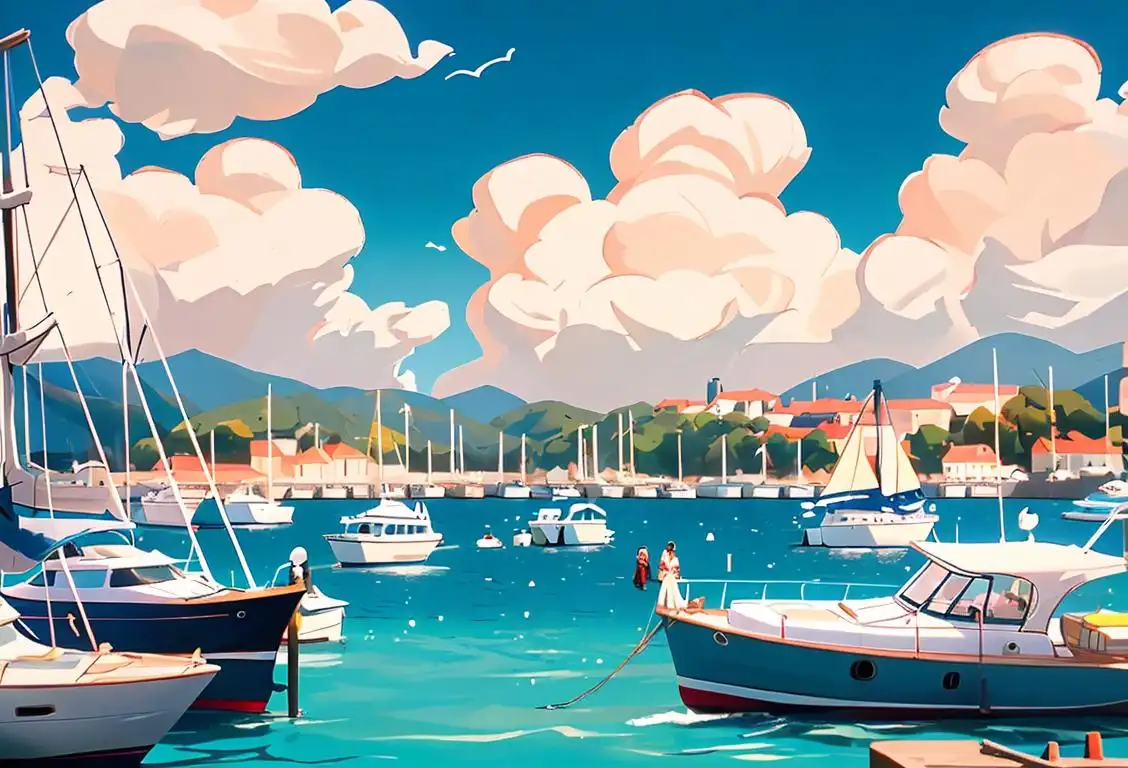National Marina Day

Ahoy there, landlubbers! Get ready to set sail on National Marina Day, a day dedicated to celebrating the wonderful world of marinas. Whether you're a boating enthusiast or just enjoy the peaceful serenity of the waterfront, this national day is all about appreciating the beauty and allure of marinas. So grab your captain's hat and join us as we dive into the internet history of this watery celebration!
When is Marina Day?
It's national marina day on the 13th June.
The Internet History of National Marina Day
On this day, marinas sail into the spotlight and become the stars of the show. The origins of National Marina Day can be traced back to a group of boating enthusiasts who saw the need to raise awareness about the crucial role marinas play in the boating community.
The first online mention of National Marina Day occurred on June 13, 2015, and since then, it has gained popularity among boaters and water lovers across the web. From blog posts sharing favorite marina destinations to social media discussions about boating adventures, the internet buzzes with excitement for this special day.
Marinas are more than just docking spots for boats; they are gateways to incredible experiences on the water. On National Marina Day, people come together to celebrate the joys of boating, share their love for all things nautical, and seek out new marina destinations to explore.
So what can you expect on this maritime holiday? Well, marinas around the country often organize fun-filled events and activities to mark the occasion. From boat parades and fishing competitions to live music and waterfront picnics, there's something for everyone!
Being at a marina is like stepping into a world of adventure and relaxation. The smell of the salty sea air, the gentle sound of the waves, and the sight of boats bobbing in the water create an atmosphere that's hard to resist. It's a place where friendships are forged, memories are made, and dreams of open seas come alive.
Did You Know?
Did you know that the world's largest marina is the Yas Marina in Abu Dhabi? Spanning over 143 hectares, this stunning marina can accommodate more than 180 yachts, including some of the most luxurious vessels in the world. It's a must-visit destination for all avid boaters!
History behind the term 'Marina'
1920
Birth of the term 'marina'
The term 'marina' was first used in the early 20th century to describe a specialized harbor or basin for small pleasure boats. It originated from the Italian and Spanish word 'marina', which means 'harbor' or 'seashore'. The term quickly gained popularity in coastal regions, particularly in Europe and North America, to refer to a dedicated area for mooring and servicing recreational boats.
1925
Birth of the term 'marina'
In the year 1925, the term 'marina' was first coined to refer to a harbor or port dedicated to recreational boating and water-based activities. The word 'marina' is derived from the Latin word 'mare', meaning 'sea', and is used to describe a protected basin or area of water where boats are docked or moored.
363 BC
The Birth of the Harbor City
In 363 BC, the Greek city of Syracuse, located on the eastern coast of Sicily, gave birth to the concept of a marina. A marina was initially a small and protected harbor designated specifically for the docking and mooring of ships.
1920
Birth of the term 'marina'
The term 'marina' originated in the 1920s to describe a harbor or basin with dock facilities and amenities for pleasure boats. It was derived from the Latin word 'mare,' meaning 'sea.' This new term reflected the emergence of recreational boating as a popular leisure activity during the early 20th century.
1875
The Birth of the Marina
In the year 1875, the term 'marina' was coined to refer to a specifically designated area for docking and mooring boats and yachts. It originated from the Latin word 'marinus,' which means 'of the sea.' The concept of the marina was born out of the increasing popularity of recreational boating and the need for a safe and convenient place for boat owners to store and maintain their vessels.
1938
Birth of the yacht club
In 1938, the concept of the marina began to take shape with the formation of the first modern yacht club. Yacht clubs were initially established as social organizations for boat owners to gather, share their passion for sailing, and engage in friendly competitions. These clubs often provided basic facilities such as anchorage, moorings, and storage for boats.
1592
Marina as a Term for Harbor
In the year 1592, the term 'marina' first emerged in the Italian language, where it was used to refer to a harbor or port. The word 'marina' is derived from the Latin word 'mare,' meaning sea. During this time, marinas primarily served as safe havens for ships, providing shelter and anchorage for sailors.
1950
Birth of a Boating Hub
The term 'marina' was first coined in the year 1950 when the concept of a modern boating hub originated. Marinas are designated areas along the coast or inland waterways where boats and yachts can be moored, serviced, and berthed. The development of marinas marked a significant shift from the traditional boatyards and harbors, providing a more convenient and comprehensive facility for boat owners and enthusiasts. This new term revolutionized the boating industry, introducing purpose-built infrastructures catering to all the needs of boat owners.
1782
The Birth of the Word
The term 'marina' originated in the year 1782. It is derived from the Italian word 'marinaio,' which means sailor. This term was primarily used to refer to a place where sailors gathered.
1960
The Rise of Recreational Boating
During the 1960s, recreational boating witnessed a surge in popularity, leading to a growing demand for marinas. With the increasing affordability of boats, more individuals and families started to embrace boating as a leisure activity. The marina culture emerged, offering boat launches, fuel stations, repair services, rentals, and other amenities. Marinas quickly became social hubs where boaters could gather, share their experiences, and participate in various recreational activities. The term 'marina' became synonymous with a thriving community centered around boating and water sports.
1940
Marinas become popular tourist destinations
During the 1940s, marinas began transforming from simple boat harbors into vibrant tourist destinations. With the rise of recreational boating as a leisure activity, marinas started offering additional amenities and services to attract visitors. This included facilities such as restaurants, shops, fuel stations, repair services, and even accommodation options like floating hotels and houseboats. Marinas became hubs of social activity and a symbol of the seaside lifestyle.
1950
Growth of leisure boating culture
During the 1950s, there was a significant increase in recreational boating and leisure activities involving boats. This growth was driven by post-war prosperity and the increasing popularity of boating as a recreational pastime. As a result, the need for dedicated facilities for boat owners and enthusiasts became more apparent.
1950
The term 'marina' emerges
By the 1950s, the word 'marina' started to be used to refer to a facility that provided docking and other amenities for private recreational boats. The term was derived from the Spanish, Italian, and French word for 'harbor' or 'seashore'. The growing popularity of recreational boating and the need for dedicated boating infrastructure led to the introduction of marinas around the world.
1920
Marinas for Leisure
In the 1920s, marinas gained popularity as places for leisure and recreation. With the increasing interest in boating and yachting, marinas started evolving into facilities that catered to boat owners and enthusiasts. These marinas provided amenities like docking services, fuel stations, and maintenance facilities.
19th Century
Marinas as Yacht Harbors
During the 19th century, marinas started to evolve into more specialized facilities. With the rising popularity of recreational boating, marinas began to cater to yacht owners and became synonymous with yacht harbors. These marinas offered amenities such as berths, refueling stations, and repair services, establishing themselves as centers for nautical leisure activities.
1920
Development of Modern Marinas
During the 1920s, marinas started to evolve into modern facilities, equipped with amenities to cater to the needs of boaters and their vessels. As more people embraced the leisurely activity of boating, the demand for marinas grew. Engineers and architects began designing marinas with improved infrastructure, including jetties, piers, fuel docks, and storage facilities to accommodate the increasing number of boats.
1928
The first documented marina in the US
In 1928, the Belmont Pier in Long Beach, California, became the first documented marina in the United States. It offered mooring for pleasure craft and provided various services and attractions for boaters. The success of the Belmont Pier marina paved the way for the development of similar facilities around the country.
15th Century
The Rise of Marinas as a Safe Haven
In the 15th century, marinas gained popularity throughout Europe due to the increasing need for safe harbors for ships. As maritime trade expanded, marinas provided a secure space for vessels to dock, refuel, undergo repairs, and seek protection from inclement weather.
1974
Marinas as Economic Drivers
In the 1970s, marinas began to be recognized not only as recreational destinations but also as potential economic drivers. Coastal towns and regions saw the value in attracting boating tourism as a means to boost local businesses and stimulate economic growth. As the popularity of marinas continued to soar, governments and private investors started investing in marina infrastructure to support the burgeoning industry. The term 'marina' became associated with a crucial component of coastal development, representing the fusion of commerce, tourism, and aquatic recreation.
1928
First Modern Marina
In the year 1928, the world's first modern marina was established in Newport Beach, California, United States. Known as the Newport Harbor Municipal Marina, it was designed to accommodate the growing interest in recreational boating. This marina set the standard for future developments, providing slips, moorings, and various services to boat owners.
1960
Marinas Go Global
By the 1960s, the popularity of recreational boating had spread worldwide, and the term 'marina' became universally recognized. Marinas started to emerge in various countries across different continents, becoming essential hubs for boating enthusiasts. Their presence significantly contributed to the development of coastal areas and waterfront tourism, attracting visitors from around the globe.
1960
Floating Marinas Innovations
By the 1960s, marina designs underwent significant changes. The introduction of floating marinas revolutionized the industry. Floating docks and platforms allowed for easier access to boats, regardless of tides or water levels. This innovation made marinas not only more practical but also aesthetically pleasing.
1950s
Marina expansion and popularity
During the 1950s, the popularity of recreational boating surged, leading to an increased demand for marina facilities. Marinas began to expand in size and offer additional services, such as fueling stations, repair shops, and restaurants. This period marked the growth of marinas as essential hubs for boating enthusiasts.
19th Century
Marinas Enter the Recreational Realm
During the 19th century, marinas began to serve recreational purposes in addition to their utilitarian function. People with an affinity for boating and yachting started using marinas as starting points for leisurely trips, and marinas evolved into social hubs where boating enthusiasts could gather, exchange stories, and showcase their vessels.
1960
Marinas become sophisticated
During the 1960s, marinas became more sophisticated with the introduction of modern infrastructure and services. Marinas began offering a wide range of amenities like fuel stations, repair and maintenance facilities, boat ramps, provisions for waste disposal, and sometimes even restaurants and shops. These developments aimed to enhance the boating experience for boat owners and attract more people to recreational boating.
1960
Expansion of marinas worldwide
In the 1960s, the popularity of marinas continued to grow globally. Many countries started investing in the development and expansion of marina infrastructure to meet the increasing demand for recreational boating. Marinas became integral parts of coastal communities, supporting local economies and tourism. The rise of luxury yachting further fueled the expansion of marina facilities, with some marinas catering exclusively to high-end vessels and offering lavish amenities.
1960
Rise of marinas as exclusive luxury destinations
In the 1960s, marinas started to transform from simple harbors into exclusive luxury destinations. Wealthy boat owners sought glamorous and well-equipped spaces to dock and showcase their vessels. Marinas began to offer upscale amenities such as yacht clubs, restaurants, swimming pools, and shopping venues to cater to this emerging demand.
1977
Marina del Rey: The world's largest man-made marina
In 1977, one of the most notable marina projects, Marina del Rey, was completed in Los Angeles, California. Marina del Rey is the world's largest man-made marina, covering over 800 acres. It has more than 4,600 boat slips and can accommodate a diverse range of vessels, from small sailboats to luxury yachts. The completion of Marina del Rey marked a significant milestone in the development of marinas as prominent boating destinations.
1990
Marinas as Environmental Stewards
By the 1990s, marinas faced increasing scrutiny regarding environmental impacts. Recognizing the need for sustainable practices, marinas began implementing measures to minimize their ecological footprint. From advanced wastewater management systems to recycling programs and eco-friendly hull coatings, marinas took proactive steps to protect the surrounding waters and wildlife habitats. This marked the era where the term 'marina' started being associated not only with recreational boating but also with responsible stewardship of the environment.
1970
Marina development as a boost to local economies
As the popularity of boating continued to rise, marina development started to play a crucial role in boosting local economies. Many coastal towns and cities saw marinas as an opportunity to attract tourism and stimulate the local economy. Marinas provided jobs, increased tourism revenue, and spurred the growth of complementary businesses such as boat repairs, marine services, and waterfront accommodations.
1970
The emergence of mega-marinas
As recreational boating became more accessible, larger marina complexes known as 'mega-marinas' started to emerge in the 1970s. These marinas were capable of accommodating hundreds or even thousands of boats, providing extensive services and leisure facilities. Mega-marinas often became significant tourist attractions themselves, drawing boating enthusiasts from around the world with prestigious events, boat shows, and luxurious amenities like spas, golf courses, and high-end dining experiences.
1978
Marina del Rey becomes the largest man-made small-craft harbor
In 1978, Marina del Rey in Los Angeles, California, became the largest man-made small-craft harbor in the world. With over 4,600 boat slips and a host of amenities, it exemplified the evolving concept of marinas as not just a place to dock boats but as lifestyle destinations. Marina del Rey helped establish the benchmark for modern marina design and functionality.
1970
Marinas on the Rise
In the 1970s, recreational boating saw a surge in popularity. As a result, marinas began to multiply rapidly, particularly in coastal areas and around popular boating destinations. The increased demand for mooring spaces and facilities led to the further development and expansion of marinas.
1975
Marinas Enhance Coastal Communities
In the year 1975, the significance of marinas as economic engines for coastal communities became more pronounced. Marinas not only provided opportunities for recreational boating but also stimulated tourism and local businesses. Many coastal towns and cities transformed their waterfronts into vibrant and attractive destinations, with marinas playing a pivotal role in their revitalization.
1920s
Marinas as Iconic Coastal Establishments
In the 1920s, marinas gained even more popularity, particularly in the United States. With the rise of the automobile culture and leisure time, marinas became iconic establishments found along the coasts, offering recreational opportunities and contributing to the blossoming seaside tourism industry.
1940s
Marinas as Tourist Destinations
In the 1940s, marinas began to transition from solely serving the boating community to becoming popular tourist destinations. The leisure and relaxation associated with boating attracted visitors who wished to enjoy the coastal atmosphere, even if they didn't own a boat themselves. Marinas started offering amenities such as restaurants, shops, and waterfront activities to cater to these tourists.
Modern Era
Marinas as Vibrant Hubs
Today, marinas have become vibrant hubs of recreational boating, tourism, and coastal living. They have evolved to offer a wide range of amenities, including boat rentals, water sports facilities, luxury accommodations, and waterfront dining. Marinas also serve as social gathering places for boating enthusiasts, hosting events, regattas, and boat shows.
Present
Marinas as Multi-Purpose Facilities
In the present day, marinas have become multi-purpose facilities, catering to the needs of diverse groups. They serve as mooring sites for recreational boats, provide access to water sports and fishing activities, offer services such as boat rentals and fueling stations, and serve as venues for various events and social gatherings.
1990
Marinas as Destination Points
In the 1990s, marinas started transforming into destination points. Many marinas developed into full-fledged resorts with amenities like restaurants, shops, hotels, and entertainment facilities. This shift turned marinas into not just places to dock boats but also to spend a complete vacation.
1990s
Marinas embrace sustainability
In the 1990s, marinas began to prioritize environmental sustainability. Many adopted practices like wastewater management, recycling programs, and eco-friendly construction techniques to minimize their ecological impact. This shift highlighted the responsibility of marinas to preserve the marine environment and played a significant role in promoting environmental consciousness among boaters.
Present
Marinas as Community Hotspots
In the present day, marinas have evolved into multifaceted community hotspots. They offer a range of amenities such as restaurants, shops, event spaces, and even residential properties. Marinas have become sought-after destinations for not just boaters but also for individuals seeking waterfront living or unique recreational experiences. With their picturesque settings and vibrant atmospheres, marinas contribute to the social fabric of coastal communities and serve as symbols of leisure, adventure, and relaxation. The term 'marina' encompasses the transformation of a simple boat docking facility into a multifunctional waterfront haven.
1980s
Marinas as economic and tourism drivers
During the 1980s, marinas increasingly became recognized as important contributors to local economies and tourism. Marinas started hosting boat shows, regattas, and other boating events, attracting visitors from near and far. The presence of marinas and the associated recreational boating activities created job opportunities in various sectors, including boat manufacturing, maintenance, hospitality, and tourism-related services.
Present
Marinas as economic and cultural hubs
Today, marinas continue to serve as important economic and cultural hubs in coastal areas. They not only provide docking and maintenance services for recreational boats but also contribute to local economies through tourism, hospitality, and water-based activities. Marinas have become synonymous with leisure, luxury, and the allure of coastal living. They offer opportunities for boating enthusiasts to explore the waters, enjoy scenic surroundings, and engage in a variety of water sports and recreational activities.
1989
First superyacht marina
In 1989, the world's first marina exclusively dedicated to superyachts (luxury mega yachts typically exceeding 24 meters in length) was established in Montenegro. This marked a new milestone in marina history, catering to the needs of ultra-wealthy individuals who desired exclusive mooring spaces with exceptional facilities and unparalleled luxury services.
Present
Marinas Adapt and Innovate
In the present day, marinas continue to thrive and adapt to changing times and demands. With advancements in technology, marinas have embraced modern amenities such as Wi-Fi connectivity, fueling stations with advanced systems, and state-of-the-art boat maintenance services. Additionally, marinas now cater to a wide range of water-based activities, including yacht clubs, sailing schools, and fishing charters, making them true recreational hubs for water enthusiasts.
Future
Marinas of Tomorrow
Looking ahead, the future of marinas holds exciting possibilities. Sustainable practices and eco-friendly design elements are increasingly being integrated into the design and operation of marinas. Concepts like floating marinas and green energy sources are gaining attention, highlighting the commitment of the boating community towards environmental preservation. Marinas of tomorrow aim to provide unparalleled experiences while ensuring the preservation and conservation of our oceans and waterways.
2000s
Marinas as lifestyle destinations
In the 2000s, marinas evolved further to become lifestyle destinations offering a wide range of activities beyond boating. Marinas began to incorporate waterfront promenades, art galleries, cultural events, and recreational facilities such as golf courses and tennis courts. They embraced a holistic approach to leisure and entertainment, attracting not only boat owners but also locals and tourists seeking a vibrant waterfront experience.
Present
Marinas adapt and thrive
In the present day, marinas continue to evolve and adapt to meet the changing needs and demands of boaters. Many marinas offer state-of-the-art facilities, including WiFi connectivity, security systems, eco-friendly practices, and recreational amenities like swimming pools and fitness centers. Marinas are not only places to dock boats but also social hubs where boating enthusiasts can connect, share experiences, and enjoy a vibrant boating community.
2000
Marinas and Environmental Sustainability
In the 21st century, marinas have increasingly focused on environmental sustainability. Many marinas have adopted eco-friendly practices, such as using renewable energy sources, implementing waste management systems, and supporting marine conservation efforts. This conscious shift aims to minimize the environmental impact and preserve the delicate marine ecosystems surrounding marinas.
Did you know?
Did you know that the world's largest marina is the Yas Marina in Abu Dhabi? Spanning over 143 hectares, this stunning marina can accommodate more than 180 yachts, including some of the most luxurious vessels in the world. It's a must-visit destination for all avid boaters!Tagged
fun leisure outdoorFirst identified
4th June 2015Most mentioned on
13th June 2015Total mentions
306Other days
Marina Day
Little Red Wagon Day
Boy Scouts Day
Golf Lovers Day
Assembly Has Quit His Day
Off Day
Go Fishing Day
Slow Down Day
Leave Work Early Day
Park In One Day








